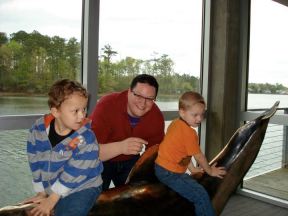To our beloved, 101 current friends on Facebook, we send these "101 + IDEAS FOR THE BIGmack Or Other Single Message Voice Output Communication Aids," compiled by Barbara Solomonson, SLP, with a great deal of help from her friends
(DOWNLOAD THE ENTIRE LIST HERE).
To the rest of you, we bid "friend us" on Facebook (link logo at the top, right of the blog info).
1. I went to a great, celebratory Christmas party for an agency for developmentally delayed adults. The Christmas program entailed the spelling of “Merry Christmas” by a group, including non-oral communicators using the BIGmack.
2. The BIGmack can be used for games such as: Chase – message “You can’t catch me!” Duck, Duck, Goose - works better with a step-by-step, Hide and Seek – “Ready or not here I come!”
3. For young children, we've used a lot of messages to initiate physical contact with them such as: "bounce me", "tickle me", “rub my back”, “brush my hair”. Obviously, you need to be conscious of whether they like this type of touch or not.
4. We have been using the BIGmack in our adult day program and are starting to purchase them for our residential programs. Many of our adults will run out of the room to use the bathroom, so we have programmed a BIGmack by the door for them to hit before they are leaving. The system can say, I will be right back, or I need to use the bathroom, or whatever the teacher feels is most appropriate.
5. We also use the BIGmack at meals to request "more" or "finished," etc
6. You could use the BIGmack and have the child's name on it, so every time it is mentioned in the story, the child could use the switch instead of the teacher reading it!
7. Use BIGmack to "order" at a restaurant
8. Tell mom and dad "I love you"
9. Ask for a hug
10. Say prayers
11. Call everyone to dinner
12. Sell items (be a barker)
13. 1 heard of a young girl who had a BIGmack attached to her horse and it said "giddy up" and the horse did just that!!!
14. I have a client who is clinically depressed and she has one that she uses with her friends. When friends come by and she's not in her dorm room, they leave a message with it. She says its the best therapy she gets to have "Hi, I'm thinking about you" messages from friends when she's not expecting them.
15. Hi, how about turning on a radio or cassette player
16. Giving a compliment to a friend
(
** Also see 102 Ideas for using a BIGmack, LINK HERE)
Some other good ones...
41. Introduce a song title at the Christmas Program
42. Ask another student to dance...
55. At Work....
• Greet customers at a department or grocery store.
• Deliver messages to co-worker.
• Inform customers about the in-store specials.
• Request more work...
78. Cheer or root for a team.
79. Comment on own new haircut, shirt, glasses, etc.
80. Draw attention (Look what I did).
81. For emergency message by telephone...
(Download the entire list, HERE!)








